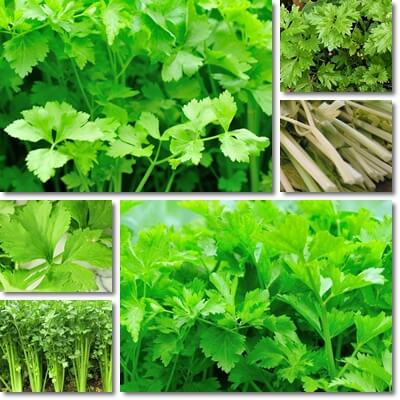Did you know there are actually three different varieties of celery? There’s celeriac, a variety of celery grown for its swollen knobby stem resembling a tuberous root. There’s the popular stalk celery grown for its straight and thick, fleshy, crisp green stems. And then there’s Chinese celery, a smaller variety of leaf celery grown for its stems and leaves and stronger celery taste. In terms of nutrition, Chinese celery is high in vitamin K and a modest source of vitamins B2, B5, B6 and B9 and dietary potassium.
It’s a good food to eat for losing weight, with anti-inflammatory and anticancer properties and benefits for high blood pressure.
What is Chinese celery?
Chinese celery is a variety of leaf celery with thinner stems and smaller leaves (compared to stalk celery varieties like the popular North American Pascal celery). The variety is known under the scientific name Apium graveolens secalinum, and is popular throughout Asia as well as in many parts of Europe, especially Balkan countries such as Romania, Bulgaria etc. Depending on where it’s used, it may be called Asian celery or European celery. Chinese celery with white stems, or simply young plants with light-colored stems may be called white Chinese celery.

What does Chinese celery look like?
At first glance, Chinese celery looks like a thinner, leafier stalk celery. The variety has quite thin, hollow, light green or greenish-white stalks that are slightly curved.
Chinese celery is a type of leaf celery and, as a result, it grows an abundance of parsley-like dark green leaves about halfway up the stalk. Depending on growing conditions, the plant may grow close to a meter in height or only 10-15 cm.
What does Chinese celery taste like?
Chinese celery is more aromatic than stalk celery, with a stronger celery taste and more intense flavor profile, but overall moderate taste intensity. The older leaves have some bitterness to them, but nothing excessive. You can eat both the leaves and stalks, raw and cooked, although Chinese celery is best cooked. The thin stalks are soft and less bitter compared to the leaves, with a faint sweet aftertaste.
How to clean and use Chinese celery
To clean Chinese celery, hold the stems by the base and introduce the ends with the leaves in a large and tall bowl of preferably cold water.
Clean with swift, but gentle back-and-forth movements for a minute, then check the water: if it’s too dirty, change the water and repeat until clean.
- Add chopped Chinese celery leaves to bean soup, vegetarian red and white bean chili or meat and bean chili, or leafy greens, mushroom and Parmesan cheese risotto towards the end of the cooking process (it requires about 10-20 minutes of cooking tops).
- Stew lightly, by themselves, or on top of a base of sautéed onions and tomatoes, for a healthy side dish to fish, chicken or other meats.
- Make a Chinese celery leaves and spinach puree: chop and sauté one onion, boil celery leaves and spinach and simmer down (20-30 minutes or so), add 3-4 crushed garlic cloves, salt, pepper and mix in sour cream or cream cheese or bechamel sauce (2 tablespoons of unsalted butter, 1-2 tablespoons of flour, 150 ml-250 ml milk). Serve with polenta.
- Chinese celery cream soup with sautéed onion, salt, pepper, dried thyme, extravirgin olive oil and thickened with sour cream, served with croutons.
- Basic vegetable stock using onions or leek, carrot and leaf celery – you can use it for vegetable soups, chicken soup, broths, risotto etc.

Chinese celery nutritional information
Chinese celery nutrition facts per 100 grams:
- High in vitamin K: over 40% of the daily recommended intake for an average adult
- Good vitamin B9 content: approximately 10% of daily values
- Modest vitamin A, B2, B5, B6 and potassium content (roughly 5% of daily values)
- Contains small amounts of vitamins B1, B3, C and E, calcium, copper, iron, magnesium, phosphorus, sodium and zinc
- Very low in calories: roughly 20 kilocalories
- Very low carbohydrate content: roughly 3 grams of carbs
- Low dietary fiber content: under 2 grams of fiber
- Very low sugar content: under 2 grams of sugar
- Very low fat content: under 0.2 grams of fat
- Very low protein content: under 1 gram of protein
Chinese celery benefits and uses
- Very low in calories, fat, carbs and sugar, Chinese celery helps you lose weight.
- Source of anti-inflammatory benefits thanks to a high vitamin K content.
- Benefits for bone mineral density thanks to a generous vitamin K content and small amounts of calcium, magnesium and phosphorus.
- Source of potassium, magnesium and bioactive 3-n-butylphthalide with proven blood pressure lowering effects.
- Neuroprotective effects owed to biologically active 3-n-butylphthalide.
- Cholesterol-lowering properties owed to dietary fiber which binds to and reduces absorption of fat from food at the intestinal level.
- Anticancer properties owed to bioactive compounds such as luteolin, apigenin, falcarinol, falcarindiol, vitamin C, vitamin K, vitamin A.
- Benefits for pregnant women: vitamin B9 in Chinese celery supports the normal development of the baby during pregnancy, reducing risks of neural tube defects.
- Minor benefits for anemia owed to vitamins B2, B5, B6 and B9 which help produce red blood cells for better tissue and muscle oxygenation, more energy and increased vitality.
Find out more! Discover the benefits of celeriac or celery root and the benefits of stalk celery.
Chinese celery side effects
Probably the biggest side effects of Chinese celery are allergic reactions culminating with anaphylactic shock which is a medical emergency. Celery, whether stalk, root or leaf, is a major allergen and can trigger allergic reactions that vary in intensity from mild to severe.
Symptoms of an allergic reaction to Chinese celery may include an itchy skin rash, swelling of the lips, tongue or throat, difficulty breathing, coughing, wheezing, closing of the airways, drop in blood pressure, dizziness, fainting and, ultimately, anaphylactic shock.
Eating too much Chinese celery is contraindicated if you are on anticoagulants because of the high content of vitamin K which promotes blood coagulation.
